Some of our favorite dog movies poke fun at dogs in shoes. And, if you want, you CAN spend a small fortune on designer footwear for your favorite canine. But that takes away from all of the good dog shoes accomplish. Because, depending on where you live and walk your dog, conditions are hazardous to dog paws. Something as simple as a well-made, top-quality dog shoe can prevent problems down the road. And we have those very options for you – some of which look quite stylish.
Outdoor Hazards
Paw pads are tough. Inside each pad, you get a shock absorber of fat. And on the outside? The thickest skin anywhere on the canine body. That makes sense considering they hold up your dog and carry them around. Without paw pads, the skeleton would take the brunt of the abuse when your dog runs, jumps, or even stands.
But while paw pads are super, they have their kryptonite. And that’s the outside world:
- Rough terrain scrapes
- Grass allergies
- Hot pavement burns
- Snow or ice balls
- Deicer irritation
That’s where dog shoes lend a helping hand. They offer the same protection your shoes give YOU.
Indoor Hazards
Unhappily, for some pups, inside is just as tricky as outside. As dogs age, their joints start to wear down. Managing to walk across floors with hard surfaces becomes more of a challenge. And you may notice your canine companion sliding around.
Another result of aging – or other disabilities – is toe-curling/toe dragging. This results from arthritis, certain spinal conditions, and even weakness. Your dog’s paw will flip upside down, allowing the top to scrape the floor or other surfaces. This can lead to raw wounds, infections, and other injuries.
But if they’re wearing dog shoes? They’ll get needed traction on the floors. And the material protects their foot, even if they toe drag.
Types of Dog Shoes
Not all dog shoes are the same. They come in different styles, intended for different purposes. If you’re looking to protect your pup from boiling pavement during walks, you’ll want one style.
But if you’re taking your adventure buddy out for hikes in the great unknown? That’s a dog hiking boot, and it’s a completely separate style.
You can find everything from dog socks (best for indoors) to climbing gear. So consider what your pup’s needs are when you start looking. And keep weather changes in mind. A fleece-lined bootie works fantastic in the winter, but in the summer? It’s NOT a good idea.
Common Features
No matter which dog shoes you decide work best for you, you want a few key features. These will ensure your dog stays safe and comfortable on their walk, whether they’re exploring the woods or heading to the park.
- Comfort: To stay on, dog shoes should stay snug around the “ankle.” You’ll want Velcro straps to help with this. But leave space in the toes (remember, dogs can’t retract their nails).
- Sole: Your dog should walk normally (once they’re used to the dog shoes). But you need a textured sole that provides traction.
- Waterproof: Rain (and snow) happen. And so do puddles and water bowls. You should look for waterproof or water-resistant materials to make sure the shoes don’t get soggy.
Choosing a Dog Shoe
If you can dream of a dog shoe, odds are you can find it. But it may not be the most practical thing. Fine if your furry friend is lounging around the apartment all day. But if they need to go out into the snow (even a cleared sidewalk) or a summer day? That’s not ideal. If you want the best dog shoes to protect those puppy paws, you want to look for the following:
- Size: Dog shoes that are too small cause your dog’s toes to curl in. Too large? And those booties come flying off. Every manufacturer uses its own sizing chart, and it’s important to read them carefully. (And, of course, measure twice, buy once)
- Material: You want to look for materials that breathe. Dogs sweat through their paw pads. So if you choose dog shoes that seal their feet, they’ll overheat – especially in the summer.
- Usability: It’d be awesome if dogs put their own shoes on, but we’re not there yet. And you don’t want to make it a stressful process. So look for dog shoes that go on and come off without too much trouble.
Dog Shoe Safety
If you aren’t sure when to break out the dog shoes, think over the common hazards. When the potential exists to cause harm to your pup’s paws, you want to put on the booties.
Hot pavement is DANGEROUS. And not everyone can walk their dog on the grass. Dog shoes make the difference. But you’ll want to take those booties off on long walks to give your pup’s tootsies a chance to breathe. (Just make sure you’re in the shade and OFF the pavement when you do so)
Plenty of pet owners use pet-safe deicers during the winter. But around commercial properties and on the road, they don’t. And those chemicals are dangerous for dog paw pads. Snow and ice are harsh, too. A cushy dog shoe can let your dog enjoy their snow day in safety and comfort. However, you want to clean those boots after every use. Sweat can build up on the interior, making it a home for bacteria.
The Best Dog Shoes
You can’t lock your dog up in a bubble. And you don’t want to ban them from the outdoors. So you pick up the best dog shoes for their needs. They may do that funny “high step” while adjusting to the booties, but they’ll adapt pretty quickly. And once they find how comfortable walking is with their new “sneakers?” You’ll find them bouncing around, eager to head out on their adventures. And you won’t need to worry about burns or scrapes.
Bark Brite offers a set of dog shoes that work well in any condition – inside or out. The neoprene offers water resistance to most weather issues (no swimming, obviously), and there’s an inner lining to keep your dog comfortable. The sole is durable rubber with a tread to aid in traction. You get two Velcro straps with reflective trim that help you get that fit perfect. And they’re a cinch to get on and off. They come in five sizes, including giant breeds.
Downsides? Neoprene isn’t waterproof, so you don’t want your dog to spend a ton of time playing in the rain or snow. And it’s not the sturdiest material. If you plan to use these dog shoes occasionally, they may work, but not for extended use. Also, the straps don’t always hold the booties in place.
The Good
- Water-resistant
- Rubber sole with tread
- Reflective trim on Velcro straps
- Available in 5 sizes
The Bad
- Not waterproof
- Not durable
- Don't stay in place
Who says you can’t find cute and functional dog shoes? CovertSafe adds paw print embroidery to each of their booties. And the breathable nylon prevents your dog’s paws from getting too warm while they’re out on their walks. The non-slip sole comes complete with treading to prevent accidental slides. And when it’s time to put those booties on? The side opens up, making it easy as pie. The Velcro strap wraps around twice, and it has reflective stitching to help with visibility.
The downsides? You have seven sizes to choose from, but the estimated weights only range from 14-95 pounds, so the smallest pups out there get left out. (Not to mention the largest) You also only get one Velcro strap, which can make getting the proper fit challenging. And the nylon’s durable and breathable but NOT waterproof. You also don’t get a lining, so you may want to consider dog socks to prevent blisters.
The Good
- Water-resistant
- Rubber sole with tread
- Reflective trim on Velcro strap
- Available in 7 sizes
The Bad
- Designed for dogs weighing 14-95 pounds
- Not waterproof
- No lining
- Don't stay in place
Whether your dog’s heading out on an adventure or playing in the snow, EXPAWLORER has the perfect dog shoes for them. The sturdy material IS waterproof, making it easy for your dog to engage in any activity. You can also handwash the booties whenever you need to. The rubber sole features grooves to provide a non-skid surface. And it comes with an extra “toe cap” to help if you have a senior that toe drags. The Velcro straps have reflective stitching, and they make sure you get a comfortable fit. And with an “expanded” opening, you won’t have to struggle to get them on or off.
So what are the downsides? Unfortunately, they don’t come with lining. That means irritation to your dog’s foot the longer they wear them. You’ll need dog socks. It’s also not the sturdiest material in the world. And while you have two Velcro straps, they’re in the same place, so it’s not difficult for dogs to get out of them.
The Good
- Waterproof
- Rubber sole with tread
- Reflective stitching on Velcro straps
- Available in 8 sizes
The Bad
- Not durable
- No lining
- Don't stay in place
Lonsuneer offers a simple dog shoe. They sandwich a layer of neoprene between two layers of mesh. That gives your dog a breathable bootie with water resistance. And they still get a non-skid sole. The Velcro strap fastens around the top, holding everything in place. You can choose from three different colors (black, blue, and red) in five sizes.
Downsides? Yeah, not waterproof. And you also don’t get any reflective options. You may want to use this dog shoe indoors. That single Velcro strap and buckle also mean plenty of dogs walk right out of them. And the mesh and neoprene won’t hold up to a lot of abuse. Oh, and double-check your measurements as people struggled with sizing.
The Good
- Water-resistant
- Rubber sole with tread
- Available in 5 sizes
The Bad
- Not waterproof
- Not durable
- No lining
- Don't stay in place
- Sizing difficulty
So PawZ may not look like your average dog shoes, but they work in a pinch. Constructed from thick rubber, they’re naturally anti-slip. And that means they’ll also protect your dog’s paws from water and heat. You don’t need any Velcro or buckles as they slide over your dog’s feet in one easy step. And at their low cost, it’s not a problem to replace them, as needed. You can find them in plenty of colors and patterns in seven different sizes, even one for tiny breeds.
The downsides? Rubber isn’t breathable, so your dog’s feet will SWEAT in these dog shoes. Make sure you take them off for breaks if you’re out in the heat. And while they’re fine for use on ordinary surfaces, they can puncture and tear easily. You don’t want to use these for hiking. And they may end up tearing on the pavement. You also won’t get a reflective option in all of those colors. And some owners struggled to pull them on – or found the elastic cutting off blood flow around their pup’s ankles!
The Good
- Waterproof
- Rubber is non-skid
- Available in 7 sizes
The Bad
- Not breathable
- Not durable
- No lining
- Can puncture or tear easily
- Difficult to get on and off
- May restrict blood flow
Petbobi makes sure your dog stays visible in their dog shoes – even without reflective strips. The fluorescent orange color stands out even in gloomy weather. And the neoprene material keeps their paws warm and cozy. The rubber sole is textured to provide traction on snow or wet pavement (or even your hardwood floor). The wide opening and Velcro strap make it easy to get the booties on and off, and it cinches them in place.
So what are the downsides? They’re listed as waterproof, but the dog shoes are made from neoprene. That’s water-resistant, not waterproof. So make sure you keep an eye on what activities you’re taking your pup out into. And while it’s easy to get them on and off, you don’t have a lot of ability to adjust that fit. You also won’t see them hold up to constant use.
The Good
- Water-resistant
- Rubber sole with tread
- Available in 5 sizes
The Bad
- Not waterproof
- Not durable
- Don't stay in place
QUMY is another dog shoe that offers you the chance to handwash the booties whenever you need. And, yes, that also means they’re waterproof. Like EXPAWLORER, you also get a toe cap extending up from the textured sole to help seniors when they’re walking. And both Velcro straps come with a wide reflective band to aid with visibility. You have seven sizes to choose from, and they come in four stylish colors, all embroidered with a paw print on the side.
Downsides? While they ARE waterproof, even QUMY advises you not to let your dog submerge the dog shoes for any length of time; water gets through the seams. People also found them to be less than durable with regular use. And those pesky Velcro strips didn’t keep the booties in place on every dog.
The Good
- Waterproof
- Rubber sole with tread
- Reflective Velcro straps
- Available in 7 sizes
The Bad
- Not durable
- Don't stay in place
Sometimes your dog’s front and back feet need different sizes. And that’s where RuffWear comes in. You can buy a set of four OR a pair of their dog shoes, whichever you need. The mesh on the outside is water-resistant, allowing your dog to play in the snow without a problem. The sole is made from Vibram – a sturdy material you find on human hiking boots, and it provides the same traction on a hiking trail as it does on the pavement. Reflective trim appears on the Velcro strap and toes, making sure your pup gets plenty of visibility. And best of all, they’re machine-washable!
The downsides? It’d be nice if they were waterproof, but breathability counts, too. Otherwise, people noticed the lack of lining. Your dog will need dog socks if they use these shoes often. And the cost is up there.
The Good
- Water-resistant
- Vibram sole with tread
- Reflective Velcro straps and toes
- Available in 8 sizes
- Machine-washable
The Bad
- Expensive
- Not waterproof
- No lining
If you’re concerned about protecting your dog inside, Ultra Paws has the dog shoes for you. The water-resistant polyester won’t hold up to snow, but it does fine for casual walks and around the house. The PVC sole is textured to prevent slipping with extra foam padding. There’s a wide opening to help you get the booties on and off, and Velcro straps make adjustments a breeze.
So what are the downsides? There’s no lining on these dog shoes. That isn’t the best if you plan to use them for your senior dog. You’ll want to add socks for comfort. You also don’t get reflective strips or stitching. But if you’re staying in the house, that’s not a big deal-breaker. Unhappily, they also aren’t the most durable option out there.
The Good
- Water-resistant
- PVC sole with tread
- Available in 8 sizes
The Bad
- Not waterproof
- Not durable
- No lining
If you want a fashionable dog shoe, ZEKOO has the answer. Your pup can look trendy while still staying cozy on their walks. The faux leather outer is waterproof and easy to clean. You only need a damp cloth! And inside, your dog gets plush lining to prevent chafing. The rubber sole has two different tread patterns to prevent slipping. The strap comes with “magic tape” (it’s Velcro) that’s easy to wrap around and settle into place over and over again. Your dog gets a comfy fit and looks great, all at the same time.
Downsides? This isn’t a breathable material. Even in cold weather, you’ll want to bring your dog in and let their feet “air out.” And while you have seven sizes to choose from, they don’t work for the biggest pups out there. The sizing chart also caused people difficulties. As did the single Velcro strap with keeping the dog shoes in place.
The Good
- Waterproof
- Rubber sole with tread
- Available in 7 sizes
The Bad
- Not breathable
- Not designed for large dogs
- Don't stay in place
- Sizing difficulty
Functional Footwear
Hot and cold. Hard and soft. Any of these conditions can cause problems for your dog’s paws. But you don’t want to deprive them of their time outside. So you pick up some dog shoes and continue with your usual walks. That’s what those booties were designed for. The fact they look adorable is a bonus.
Once you train your dog to accept dog shoes, they’ll wear them without a problem. And then you can keep them safe and comfortable – no matter where they’re walking.

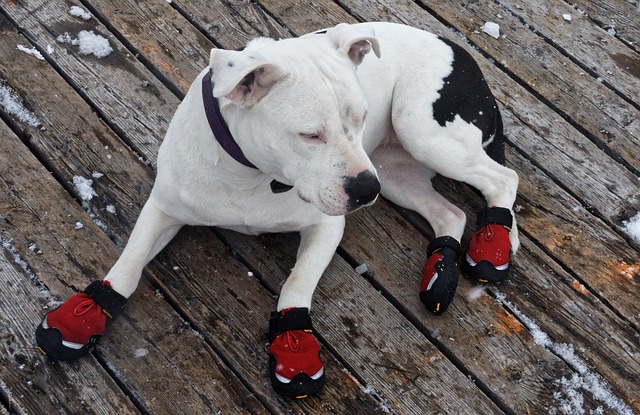
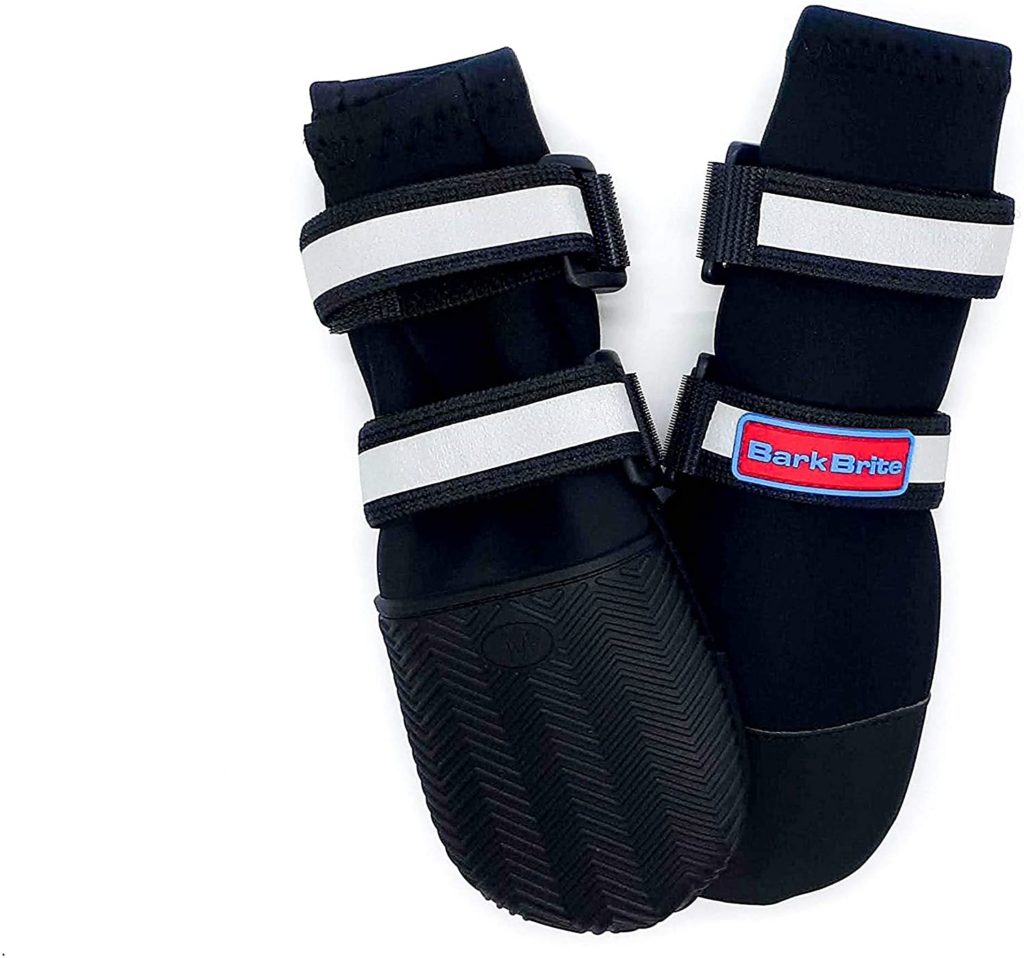
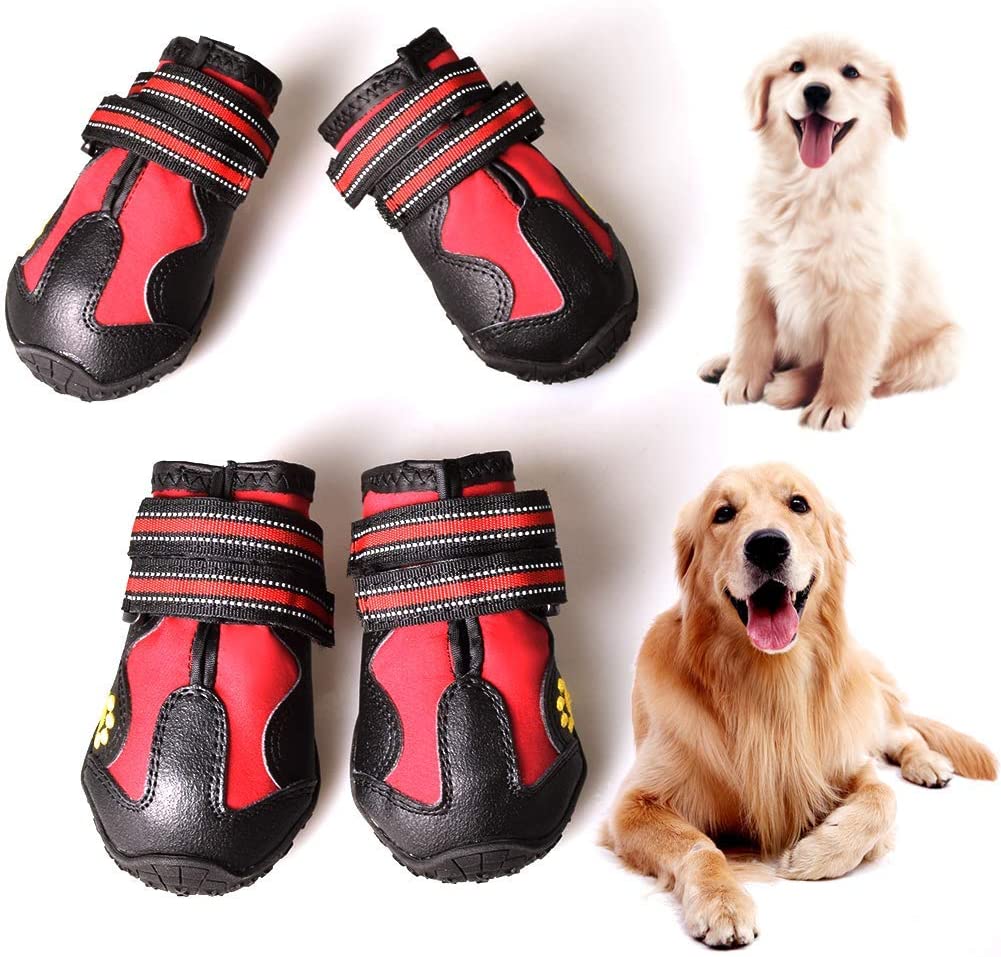
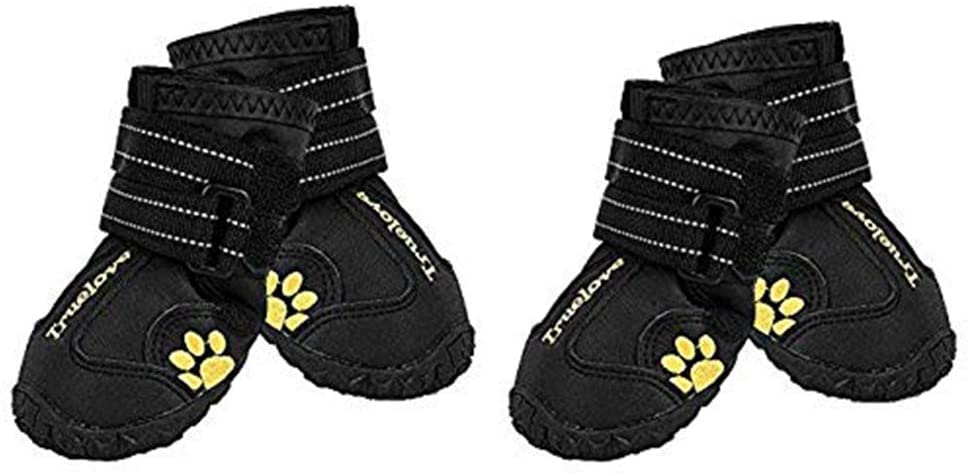
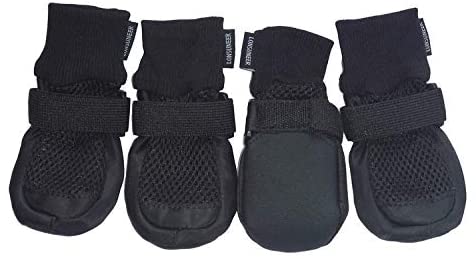

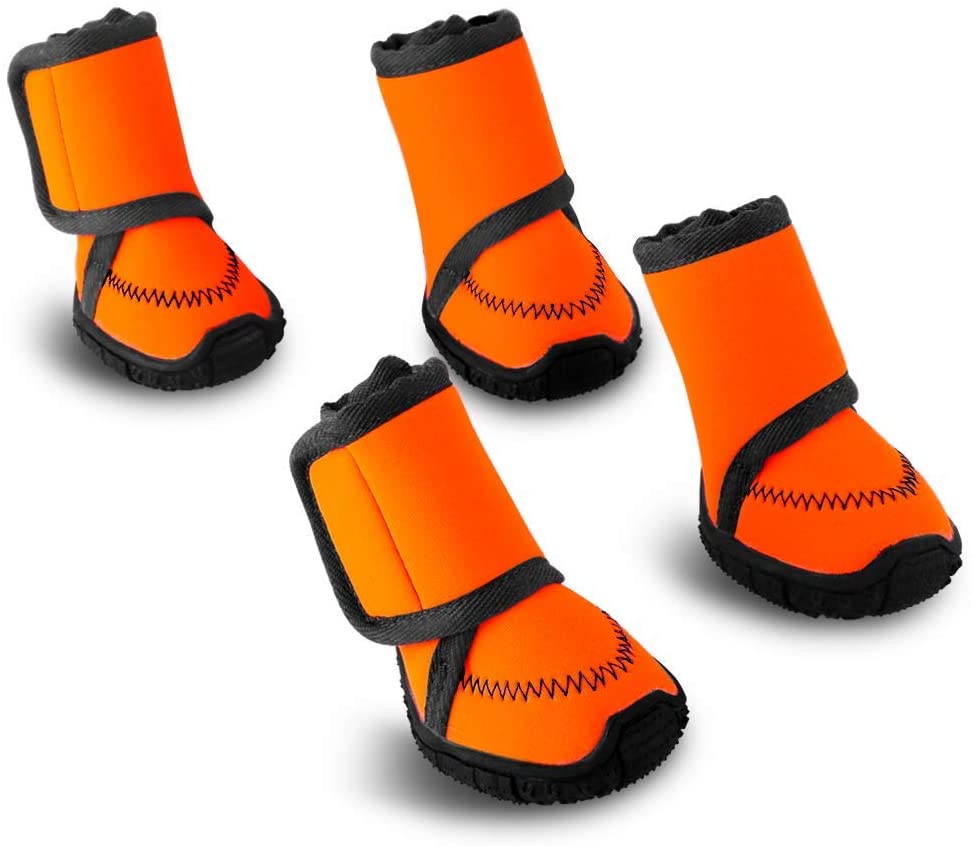
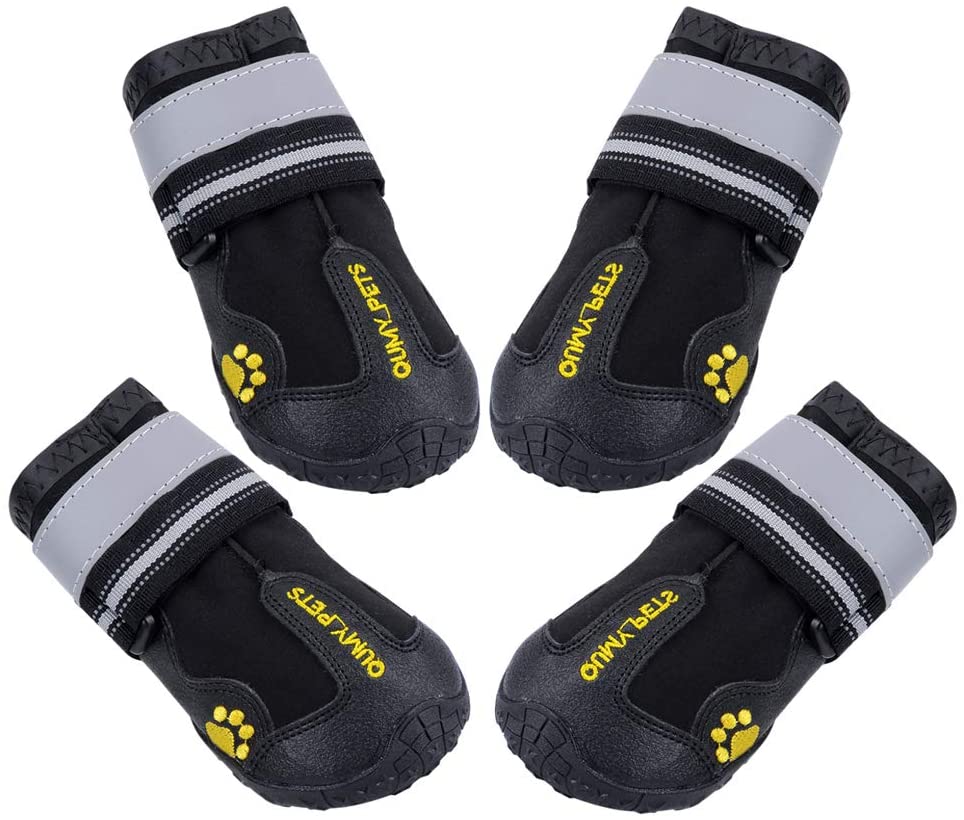
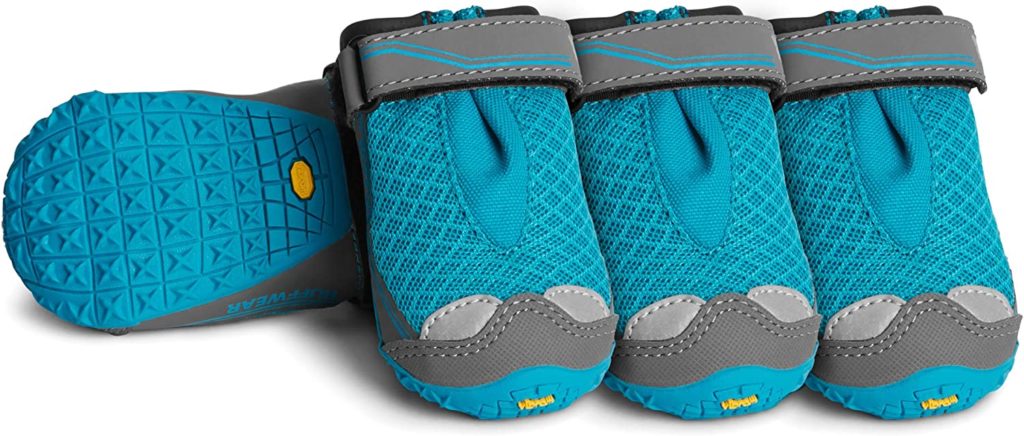
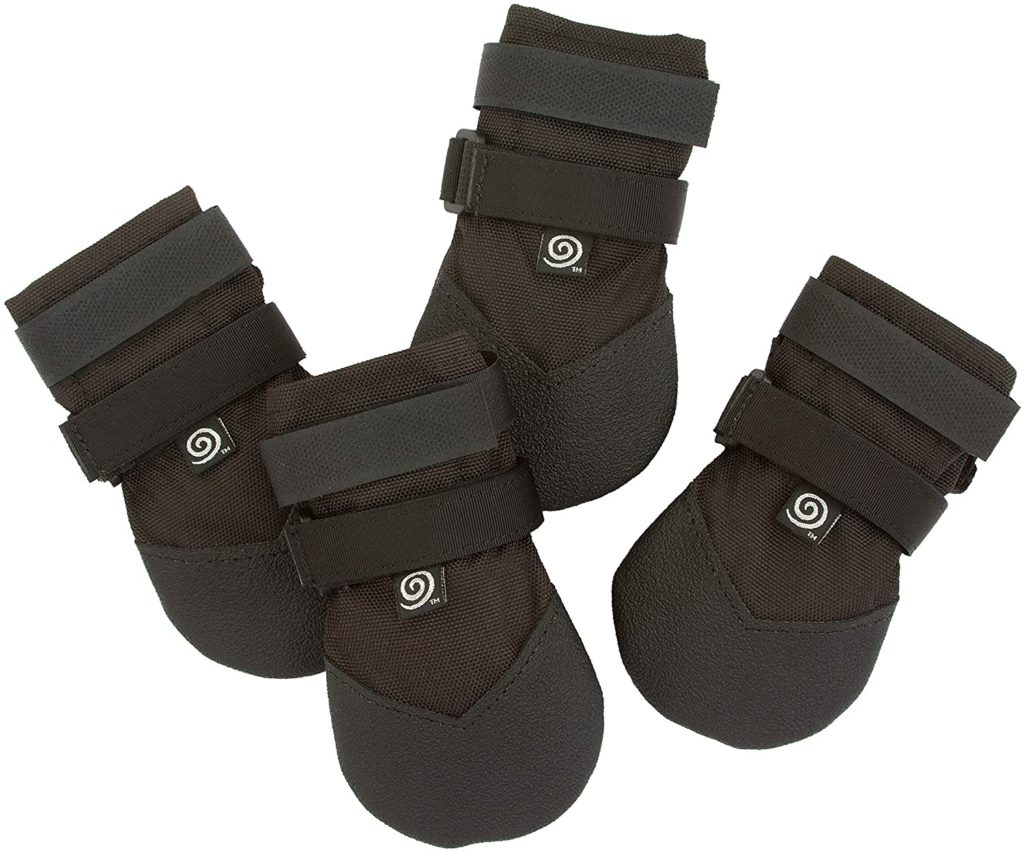
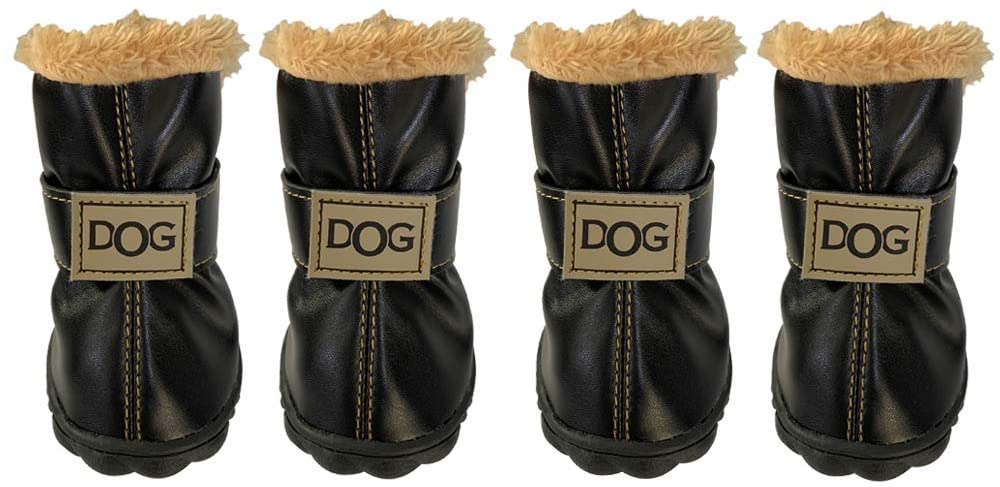




1 Comment
Thanks for taking the time to research all this. And big thanks from our fluffy shipooh too.